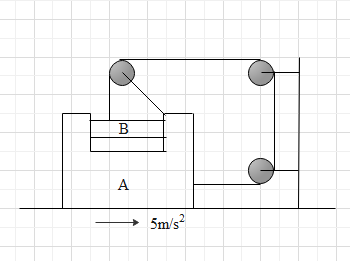Answer
394.2k+ views
Hint: From the diagram we can observe that the block B will have two accelerations. One is due to the acceleration of the block A in the same direction and the other is vertically downward. The vertical acceleration can be found from the change in length of the string in the different parts due to the movement of the block A. Then we can find the resultant acceleration with the help of vector addition.
Complete step by step answer:
The block A and block B are connected to each other by a string of constant length. Again, block B is always in contact with the block A. so, the block B will have two accelerations. Because block B is always in contact with the block A, block B will have a horizontal acceleration equal to the acceleration of block A. Again, when the block A accelerates towards right, block B will accelerate towards the bottom direction. So, block B will also have a vertical acceleration. We can find the total acceleration by vector addition of these two accelerations.

Given, block A is accelerating towards right with $a=5m{{s}^{-2}}$
Now, the horizontal acceleration of the block B is equal to the acceleration of the block A. so,
${{a}_{1}}=a=5m{{s}^{-2}}$
Now, the total length of the string is constant. So, we can write that,
${{l}_{1}}+{{l}_{2}}+{{l}_{3}}+{{l}_{4}}=\text{constant}$
Double differentiating both sides of the above equation with respect to time, we get that,
$\dfrac{{{d}^{2}}{{l}_{1}}}{{{d}^{2}}t}+\dfrac{{{d}^{2}}{{l}_{2}}}{{{d}^{2}}t}+\dfrac{{{d}^{2}}{{l}_{3}}}{{{d}^{2}}t}+\dfrac{{{d}^{2}}{{l}_{4}}}{{{d}^{2}}t}=0$
Now, since the block A is accelerating, the lengths ${{l}_{1}},\text{ }{{l}_{3}}\text{ and }{{l}_{4}}$ will change according to the acceleration. But the length ${{l}_{2}}$ will not change, because the distance between the two pulleys is constant. So, we can write,
$\begin{align}
& -a+0-a+{{a}_{2}}=0 \\
& {{a}_{2}}=2a \\
\end{align}$
The negative sign before a is because the length of the string is decreasing with time.
We get that, ${{a}_{1}}=a$ and ${{a}_{2}}=2a$
Taking the vector sum of these two, we get that the acceleration of the block B is,
$\begin{align}
& {{a}_{B}}=\sqrt{a_{1}^{2}+a_{2}^{2}} \\
& {{a}_{B}}=\sqrt{{{a}^{2}}+{{\left( 2a \right)}^{2}}} \\
& {{a}_{B}}=\sqrt{5{{a}^{2}}} \\
& {{a}_{B}}=a\sqrt{5} \\
\end{align}$
Putting the value of a we get that the acceleration of block B is ${{a}_{B}}=5\sqrt{5}m{{s}^{-2}}$
So, the correct answer is “Option C”.
Note: When we find the acceleration from the change in lengths of the string in different parts, due to the change in length of ${{l}_{1}}$ and ${{l}_{3}}$ will be negative. This is because due to the acceleration of block A, with time the lengths will decrease. But, due to the change in ${{l}_{4}}$ the acceleration is positive. This is because with time the length will increase because of acceleration of block A.
Complete step by step answer:
The block A and block B are connected to each other by a string of constant length. Again, block B is always in contact with the block A. so, the block B will have two accelerations. Because block B is always in contact with the block A, block B will have a horizontal acceleration equal to the acceleration of block A. Again, when the block A accelerates towards right, block B will accelerate towards the bottom direction. So, block B will also have a vertical acceleration. We can find the total acceleration by vector addition of these two accelerations.

Given, block A is accelerating towards right with $a=5m{{s}^{-2}}$
Now, the horizontal acceleration of the block B is equal to the acceleration of the block A. so,
${{a}_{1}}=a=5m{{s}^{-2}}$
Now, the total length of the string is constant. So, we can write that,
${{l}_{1}}+{{l}_{2}}+{{l}_{3}}+{{l}_{4}}=\text{constant}$
Double differentiating both sides of the above equation with respect to time, we get that,
$\dfrac{{{d}^{2}}{{l}_{1}}}{{{d}^{2}}t}+\dfrac{{{d}^{2}}{{l}_{2}}}{{{d}^{2}}t}+\dfrac{{{d}^{2}}{{l}_{3}}}{{{d}^{2}}t}+\dfrac{{{d}^{2}}{{l}_{4}}}{{{d}^{2}}t}=0$
Now, since the block A is accelerating, the lengths ${{l}_{1}},\text{ }{{l}_{3}}\text{ and }{{l}_{4}}$ will change according to the acceleration. But the length ${{l}_{2}}$ will not change, because the distance between the two pulleys is constant. So, we can write,
$\begin{align}
& -a+0-a+{{a}_{2}}=0 \\
& {{a}_{2}}=2a \\
\end{align}$
The negative sign before a is because the length of the string is decreasing with time.
We get that, ${{a}_{1}}=a$ and ${{a}_{2}}=2a$
Taking the vector sum of these two, we get that the acceleration of the block B is,
$\begin{align}
& {{a}_{B}}=\sqrt{a_{1}^{2}+a_{2}^{2}} \\
& {{a}_{B}}=\sqrt{{{a}^{2}}+{{\left( 2a \right)}^{2}}} \\
& {{a}_{B}}=\sqrt{5{{a}^{2}}} \\
& {{a}_{B}}=a\sqrt{5} \\
\end{align}$
Putting the value of a we get that the acceleration of block B is ${{a}_{B}}=5\sqrt{5}m{{s}^{-2}}$
So, the correct answer is “Option C”.
Note: When we find the acceleration from the change in lengths of the string in different parts, due to the change in length of ${{l}_{1}}$ and ${{l}_{3}}$ will be negative. This is because due to the acceleration of block A, with time the lengths will decrease. But, due to the change in ${{l}_{4}}$ the acceleration is positive. This is because with time the length will increase because of acceleration of block A.
Recently Updated Pages
Assertion The resistivity of a semiconductor increases class 13 physics CBSE

The branch of science which deals with nature and natural class 10 physics CBSE

What is the stopping potential when the metal with class 12 physics JEE_Main

The momentum of a photon is 2 times 10 16gm cmsec Its class 12 physics JEE_Main

How do you arrange NH4 + BF3 H2O C2H2 in increasing class 11 chemistry CBSE

Is H mCT and q mCT the same thing If so which is more class 11 chemistry CBSE

Trending doubts
Difference between Prokaryotic cell and Eukaryotic class 11 biology CBSE

Fill the blanks with the suitable prepositions 1 The class 9 english CBSE

Write an application to the principal requesting five class 10 english CBSE

Difference Between Plant Cell and Animal Cell

a Tabulate the differences in the characteristics of class 12 chemistry CBSE

Change the following sentences into negative and interrogative class 10 english CBSE

What organs are located on the left side of your body class 11 biology CBSE

Discuss what these phrases mean to you A a yellow wood class 9 english CBSE

List some examples of Rabi and Kharif crops class 8 biology CBSE




